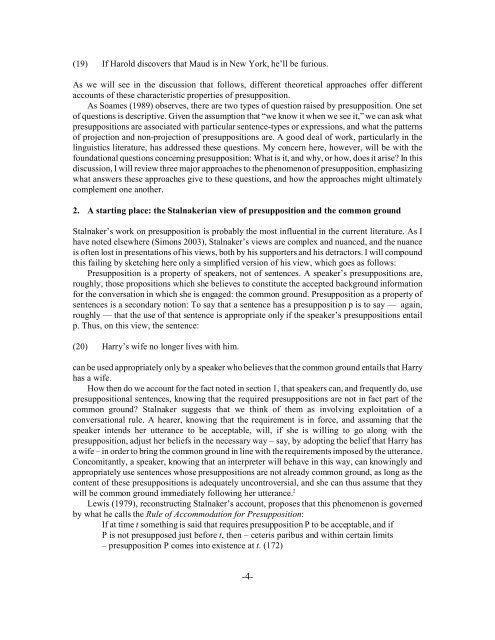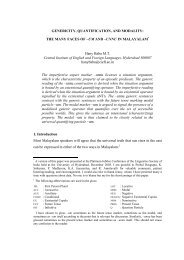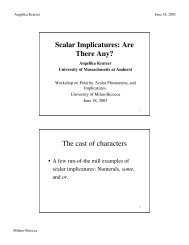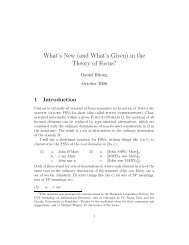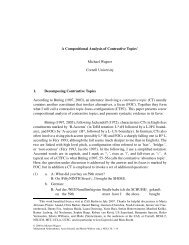Foundational Issues in Presupposition - New York University
Foundational Issues in Presupposition - New York University
Foundational Issues in Presupposition - New York University
You also want an ePaper? Increase the reach of your titles
YUMPU automatically turns print PDFs into web optimized ePapers that Google loves.
(19) If Harold discovers that Maud is <strong>in</strong> <strong>New</strong> <strong>York</strong>, he’ll be furious.<br />
As we will see <strong>in</strong> the discussion that follows, different theoretical approaches offer different<br />
accounts of these characteristic properties of presupposition.<br />
As Soames (1989) observes, there are two types of question raised by presupposition. One set<br />
of questions is descriptive. Given the assumption that “we know it when we see it,” we can ask what<br />
presuppositions are associated with particular sentence-types or expressions, and what the patterns<br />
of projection and non-projection of presuppositions are. A good deal of work, particularly <strong>in</strong> the<br />
l<strong>in</strong>guistics literature, has addressed these questions. My concern here, however, will be with the<br />
foundational questions concern<strong>in</strong>g presupposition: What is it, and why, or how, does it arise? In this<br />
discussion, I will review three major approaches to the phenomenon of presupposition, emphasiz<strong>in</strong>g<br />
what answers these approaches give to these questions, and how the approaches might ultimately<br />
complement one another.<br />
2. A start<strong>in</strong>g place: the Stalnakerian view of presupposition and the common ground<br />
Stalnaker’s work on presupposition is probably the most <strong>in</strong>fluential <strong>in</strong> the current literature. As I<br />
have noted elsewhere (Simons 2003), Stalnaker’s views are complex and nuanced, and the nuance<br />
is often lost <strong>in</strong> presentations of his views, both by his supporters and his detractors. I will compound<br />
this fail<strong>in</strong>g by sketch<strong>in</strong>g here only a simplified version of his view, which goes as follows:<br />
<strong>Presupposition</strong> is a property of speakers, not of sentences. A speaker’s presuppositions are,<br />
roughly, those propositions which she believes to constitute the accepted background <strong>in</strong>formation<br />
for the conversation <strong>in</strong> which she is engaged: the common ground. <strong>Presupposition</strong> as a property of<br />
sentences is a secondary notion: To say that a sentence has a presupposition p is to say — aga<strong>in</strong>,<br />
roughly — that the use of that sentence is appropriate only if the speaker’s presuppositions entail<br />
p. Thus, on this view, the sentence:<br />
(20) Harry’s wife no longer lives with him.<br />
can be used appropriately only by a speaker who believes that the common ground entails that Harry<br />
has a wife.<br />
How then do we account for the fact noted <strong>in</strong> section 1, that speakers can, and frequently do, use<br />
presuppositional sentences, know<strong>in</strong>g that the required presuppositions are not <strong>in</strong> fact part of the<br />
common ground? Stalnaker suggests that we th<strong>in</strong>k of them as <strong>in</strong>volv<strong>in</strong>g exploitation of a<br />
conversational rule. A hearer, know<strong>in</strong>g that the requirement is <strong>in</strong> force, and assum<strong>in</strong>g that the<br />
speaker <strong>in</strong>tends her utterance to be acceptable, will, if she is will<strong>in</strong>g to go along with the<br />
presupposition, adjust her beliefs <strong>in</strong> the necessary way – say, by adopt<strong>in</strong>g the belief that Harry has<br />
a wife – <strong>in</strong> order to br<strong>in</strong>g the common ground <strong>in</strong> l<strong>in</strong>e with the requirements imposed by the utterance.<br />
Concomitantly, a speaker, know<strong>in</strong>g that an <strong>in</strong>terpreter will behave <strong>in</strong> this way, can know<strong>in</strong>gly and<br />
appropriately use sentences whose presuppositions are not already common ground, as long as the<br />
content of these presuppositions is adequately uncontroversial, and she can thus assume that they<br />
will be common ground immediately follow<strong>in</strong>g her utterance. 2<br />
Lewis (1979), reconstruct<strong>in</strong>g Stalnaker’s account, proposes that this phenomenon is governed<br />
by what he calls the Rule of Accommodation for <strong>Presupposition</strong>:<br />
If at time t someth<strong>in</strong>g is said that requires presupposition P to be acceptable, and if<br />
P is not presupposed just before t, then – ceteris paribus and with<strong>in</strong> certa<strong>in</strong> limits<br />
– presupposition P comes <strong>in</strong>to existence at t. (172)<br />
-4-


